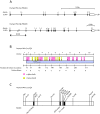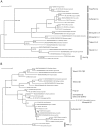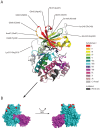Evolutionary paths of the cAMP-dependent protein kinase (PKA) catalytic subunits
- PMID: 23593352
- PMCID: PMC3625193
- DOI: 10.1371/journal.pone.0060935
Evolutionary paths of the cAMP-dependent protein kinase (PKA) catalytic subunits
Abstract
3',5'-cyclic adenosine monophosphate (cAMP) dependent protein kinase or protein kinase A (PKA) has served as a prototype for the large family of protein kinases that are crucially important for signal transduction in eukaryotic cells. The PKA catalytic subunits Cα and Cβ, encoded by the two genes PRKACA and PRKACB, respectively, are among the best understood and characterized human kinases. Here we have studied the evolution of this gene family in chordates, arthropods, mollusks and other animals employing probabilistic methods and show that Cα and Cβ arose by duplication of an ancestral PKA catalytic subunit in a common ancestor of vertebrates. The two genes have subsequently been duplicated in teleost fishes. The evolution of the PRKACG retroposon in simians was also investigated. Although the degree of sequence conservation in the PKA Cα/Cβ kinase family is exceptionally high, a small set of signature residues defining Cα and Cβ subfamilies were identified. These conserved residues might be important for functions that are unique to the Cα or Cβ clades. This study also provides a good example of a seemingly simple phylogenetic problem which, due to a very high degree of sequence conservation and corresponding weak phylogenetic signals, combined with problematic nonphylogenetic signals, is nontrivial for state-of-the-art probabilistic phylogenetic methods.
Conflict of interest statement
Figures





Similar articles
-
The Tails of Protein Kinase A.Mol Pharmacol. 2022 Apr;101(4):219-225. doi: 10.1124/molpharm.121.000315. Epub 2021 Jul 30. Mol Pharmacol. 2022. PMID: 34330820 Free PMC article. Review.
-
PKA Cβ: a forgotten catalytic subunit of cAMP-dependent protein kinase opens new windows for PKA signaling and disease pathologies.Biochem J. 2021 Jun 11;478(11):2101-2119. doi: 10.1042/BCJ20200867. Biochem J. 2021. PMID: 34115095 Review.
-
Evolution of the cAMP-dependent protein kinase (PKA) catalytic subunit isoforms.PLoS One. 2017 Jul 25;12(7):e0181091. doi: 10.1371/journal.pone.0181091. eCollection 2017. PLoS One. 2017. PMID: 28742821 Free PMC article.
-
Germline and Mosaic Variants in PRKACA and PRKACB Cause a Multiple Congenital Malformation Syndrome.Am J Hum Genet. 2020 Nov 5;107(5):977-988. doi: 10.1016/j.ajhg.2020.09.005. Epub 2020 Oct 14. Am J Hum Genet. 2020. PMID: 33058759 Free PMC article.
-
Identification and characterization of novel mutations in the human gene encoding the catalytic subunit Calpha of protein kinase A (PKA).PLoS One. 2012;7(4):e34838. doi: 10.1371/journal.pone.0034838. Epub 2012 Apr 13. PLoS One. 2012. PMID: 22514673 Free PMC article.
Cited by
-
Analysis of a Novel Peptide That Is Capable of Inhibiting the Enzymatic Activity of the Protein Kinase A Catalytic Subunit-Like Protein from Trypanosoma equiperdum.Protein J. 2023 Dec;42(6):709-727. doi: 10.1007/s10930-023-10153-1. Epub 2023 Sep 15. Protein J. 2023. PMID: 37713008
-
The Tails of Protein Kinase A.Mol Pharmacol. 2022 Apr;101(4):219-225. doi: 10.1124/molpharm.121.000315. Epub 2021 Jul 30. Mol Pharmacol. 2022. PMID: 34330820 Free PMC article. Review.
-
Investigation of high fecundity genes by nanopore sequencing in sheep (Ovis aries) pituitary.BMC Genomics. 2025 Jun 5;26(1):564. doi: 10.1186/s12864-025-11732-5. BMC Genomics. 2025. PMID: 40474086 Free PMC article.
-
Timosaponin A3 Induces Anti-Obesity and Anti-Diabetic Effects In Vitro and In Vivo.Int J Mol Sci. 2024 Mar 2;25(5):2914. doi: 10.3390/ijms25052914. Int J Mol Sci. 2024. PMID: 38474161 Free PMC article.
-
Disrupting the Allosteric Interaction between the Plasmodium falciparum cAMP-dependent Kinase and Its Regulatory Subunit.J Biol Chem. 2016 Dec 2;291(49):25375-25386. doi: 10.1074/jbc.M116.750174. Epub 2016 Oct 13. J Biol Chem. 2016. PMID: 27738107 Free PMC article.
References
-
- Manning G, Whyte DB, Martinez R, Hunter T, Sudarsanam S (2002) The protein kinase complement of the human genome. Science 298: 1912–1934. - PubMed
-
- Skålhegg BS, Taskén K (2000) Specificity in the cAMP/PKA signaling pathway. Differential expression, regulation, and subcellular localization of subunits of PKA. Front Biosci 5: D678–D693. - PubMed
-
- Taylor SS, Yang J, Wu J, Haste NM, Radzio-Andzelm E, et al. (2004) PKA: a portrait of protein kinase dynamics. Biochim Biophys Acta 1697: 259–269. - PubMed
-
- Krebs EG, Beavo JA (1979) Phosphorylation-dephosphorylation of enzymes. Annu Rev Biochem 48: 923–959. - PubMed
-
- Kim C, Xuong NH, Taylor SS (2005) Crystal structure of a complex between the catalytic and regulatory (RIα) subunits of PKA. Science 307: 690–696. - PubMed
Publication types
MeSH terms
Substances
LinkOut - more resources
Full Text Sources
Other Literature Sources
Miscellaneous

